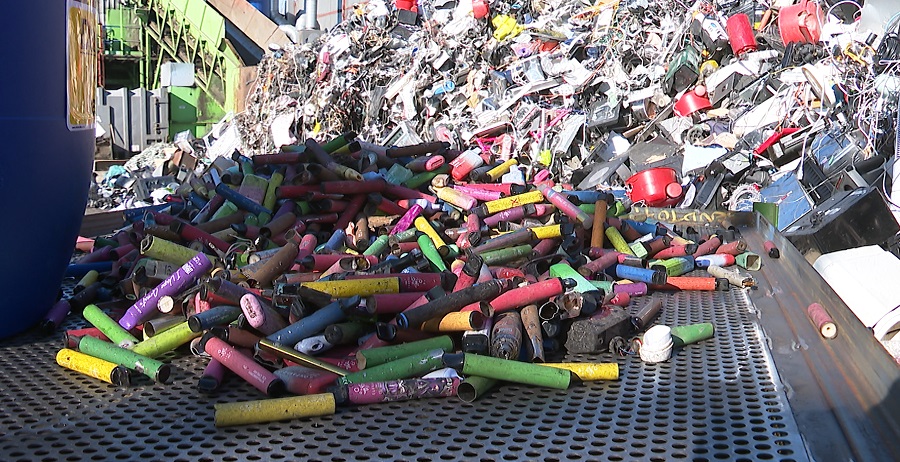30 Nov 2024

Rosmel Rodríguez
EU Climate Pact Ambassador
Since these devices are designed for single use, once exhausted, they become part of the avalanche of technological garbage.

The impact of technology on contemporary society is undeniable. From how we communicate to the way we consume, the digital age has reshaped everyday life. One of the sectors that has undergone a radical change due to this revolution is smoking, with the emergence and proliferation of electronic cigarettes and vapourisers. Many have embraced these devices as a panacea, believing they have found a "healthier" alternative to conventional cigarettes. However, the outlook is not as promising as it seems at first glance, particularly with regard to disposable vapourisers.
Emerging as an alternative to traditional tobacco, vapourisers quickly gained followers. The main appeal lies in their promise to deliver nicotine without the thousands of harmful chemicals present in cigarettes. However, in this transition from analogue to digital, new problems arose, particularly with disposable vapourisers. These devices, designed to be used once and then discarded, are leaving an alarming ecological footprint.
First, we must consider the production of these vapourisers. The manufacturing of each device involves the use of plastics, metals, and other non-biodegradable materials. These components, once discarded, not only contribute to the already overloaded problem of solid waste but can also leach chemicals into the environment. Unlike other electronic products, many disposable vapourisers are not properly recycled, partly due to a lack of awareness and partly because of the absence of recycling infrastructures specifically designed for them.
Additionally, these vapourisers contain lithium batteries, an element that, although essential for many modern electronic devices, has a supply chain with serious environmental and ethical issues. Lithium extraction often involves large mining operations that can cause damage to fragile ecosystems, water pollution, and displacement of communities.
Although the original intention of vapourisers was to reduce the consumption of traditional cigarettes, the easy availability and perception of being less harmful have led to an increase in their use, especially among the young. This increase in demand inevitably leads to greater production and, consequently, more waste.
Environmental Pollution: The Problem of Disposables
Technological evolution and consumerism have propelled the emergence of a "disposable culture". This is defined by the tendency of consumers to prefer single-use or short-lived products due to their convenience, often neglecting the environmental impact and long-term sustainability.
The massive adoption of disposable vapourisers is a tangible example of this mentality. They emerged as a response to this desire for convenience, but their environmental footprint could be a negative legacy that lasts long after their usefulness has ended.
A Mountain of Waste
The proliferation of disposable vapourisers has increased the problem of electronic and plastic waste. Since these devices are designed for single use, once exhausted, they become part of the avalanche of technological garbage. According to a study cited in the "Journal of Environmental Management", these devices add tons of waste each year to an already overwhelmed system.
To contextualise, the "Global E-Waste Monitor" in its 2019 report noted that approximately 53.6 million metric tonnes of electronic waste were generated worldwide. And although disposable vapourisers are only a fraction of this total, their contribution is significant, especially considering how quickly they have gained popularity.
Moreover, the components of these devices, mainly plastics and metals, are not biodegradable. This means that, once discarded in landfills, they persist in the environment, taking hundreds or even thousands of years to completely degrade. During this long process, they can release toxic substances into the soil and water sources, affecting the quality of these vital resources.
The Shadow of Lithium
Lithium, an essential component in the batteries of disposable vapourisers, presents its own set of environmental challenges. Lithium mining can cause community displacement, excessive water use, and pollution. According to the “World Resources Institute”, the boom in technology and demand for batteries has led to a 58% increase in lithium extraction in recent years.
Mining operations often require large amounts of water, which can deplete local water resources and affect surrounding ecosystems. Additionally, lithium extraction can result in the release of toxic chemicals that contaminate both water and soil.
The pollution problem goes beyond the simple accumulation of visible waste in our environment. In many cases, the most insidious threat comes from invisible or microscopic pollutants that, although not visible to the naked eye, have devastating long-term effects. Vape cartridges are a perfect example of this problem.
Chemical Compounds: Vape cartridges not only contain nicotine but a mixture of chemicals including propylene glycol, vegetable glycerine, flavourings, and other additives. As they break down, these chemicals can leach into the environment.
Water Pollution: When the chemicals contained in the cartridges leach into the soil, they can reach underground water sources. Once in the water, these compounds can be difficult to remove and may eventually end up in our drinking water supply systems.
Effects on Wildlife: Animals, particularly those living in or near water sources, can consume contaminated water or food that has absorbed these chemicals. This can have toxic effects on wildlife, affecting the reproduction, growth, and survival of different species.
Accumulation in the Food Chain: As small organisms consume water and food contaminated with chemicals, the chemicals accumulate in their systems. Predators feeding on these organisms then ingest concentrated amounts of these chemicals, and so on up the food chain, potentially reaching humans.
Challenges in Detection: Detecting these hidden pollutants in the early stages of filtration can be challenging, as it requires constant monitoring and specialised technology. Without proper detection and treatment, these pollutants can remain in the environment for long periods.
The threat of hidden pollutants reinforces the need for proper waste management and more sustainable design in products like vapourisers. It is imperative to invest in research and development to find safer and more sustainable solutions, and to implement stricter practices and regulations to prevent environmental pollution.
Health Risks: Beyond Nicotine
It is undeniable that the emergence of vaporizers on the market has revolutionized the way many people consume nicotine. The appeal of these devices lies in their promise to be a "safer" alternative to traditional cigarettes. However, how true is this claim? Although some arguments from manufacturers might have a basis, scientific evidence suggests that the reality is more complex than it seems at first glance.

The World Health Organization has conducted a comprehensive analysis of vaporizers and their impact on health. Although these devices release fewer toxic substances compared to conventional cigarettes, it does not mean they are completely safe. In fact, vaporizer users still inhale a variety of chemicals that can be harmful to health. These chemicals, which include aldehydes, metals, and volatile organic compounds, have been associated with respiratory conditions, cardiovascular diseases, and other health problems.
Moreover, there are concerns about the actual amount of nicotine that these devices can deliver. Some vaporizers can release nicotine levels comparable or even higher than conventional cigarettes, which can increase the risk of addiction and other health-related problems.
The Way Forward: Prohibition or Regulation?
Environmental awareness is essential in our contemporary society, where sustainability and environmental protection must be priorities. Given the growing evidence on the harmful impact of disposable vaporizers, both on public health and the environment, the intervention of authorities is essential to set a clear direction and protect society and the planet.
In Defence of Prohibition
Advocating for a total ban on single-use vaporizers is a direct response to environmental damages and public health concerns. By removing them from the market, a powerful message about prioritizing the welfare of society and the environment is sent. Regulators have the primary responsibility to ensure the safety and health of the population, and given the accumulating evidence on the risks of vaporizers, the need for intervention is indisputable.
However, commercial and political reality reminds us that solutions like prohibition often face strong resistance. The business lobby behind disposable vaporizers is powerful and may represent a significant obstacle to prohibitive measures. Faced with this, the path of regulation emerges as a "viable" alternative that could act as a middle ground. Some regulatory actions could include:
Special Taxes: By increasing the tax burden on these products, their acquisition is discouraged, while funds that could be allocated to ecological and awareness-raising initiatives are collected.
Promoting Sustainable Alternatives: Authorities have the ability to promote innovation. Encouraging the development of reusable or biodegradable vaporizers can offer more ecological options to consumers.
Recycling Programs: Establishing robust collection and recycling systems for these devices can mitigate their environmental impact. Education campaigns can play a crucial role in this aspect.
Although the prohibition of disposable vaporizers might be the ideal that many activists desire, the resistance of the industry and the need for balanced solutions suggest that smart and effective regulation could be the first step towards a more sustainable future.
The alarm is sounding, and we cannot afford to ignore it. The threat posed by disposable vaporizers not only jeopardizes our health but also the integrity of our planet.
Authorities have an unavoidable responsibility: to act now, with firmness and urgency. Every moment we allow these devices to circulate without strict regulations, we are risking the well-being of present and future generations. Prohibition could be the bold first step towards a safer future, but we need a comprehensive strategy that addresses every aspect of this complex problem. There is no time to waste; action is imperative, and the moment is now.
Rosmel Rodríguez
EU Climate Pact Ambassador
Comment
Reply